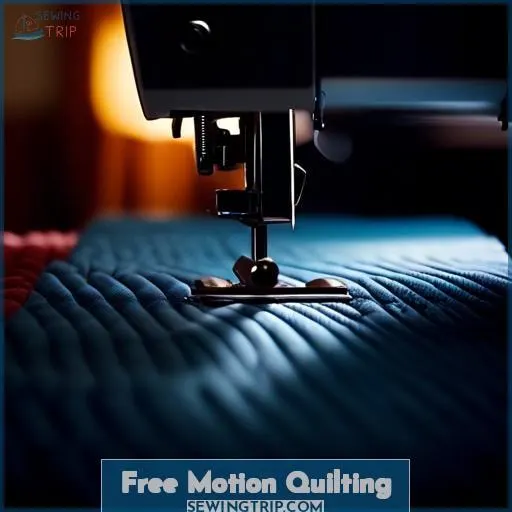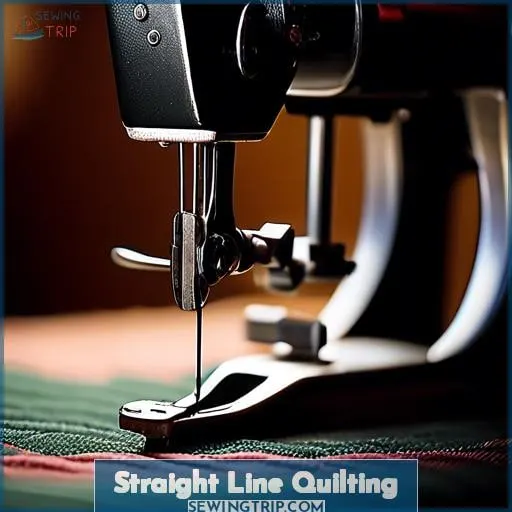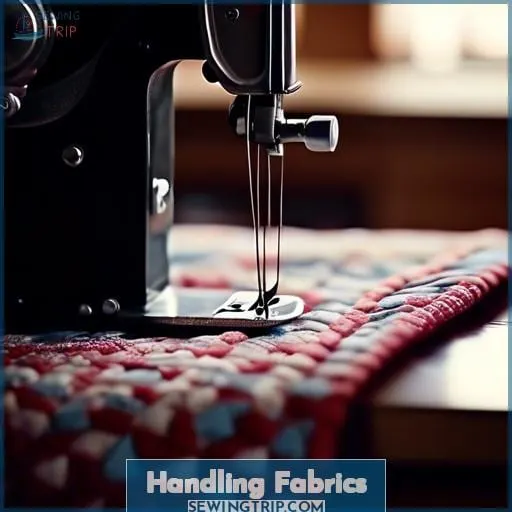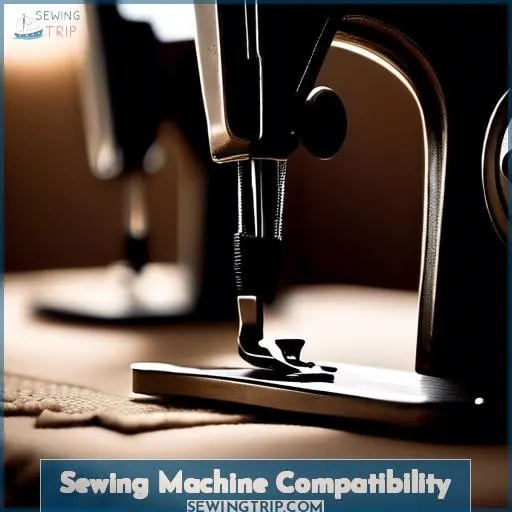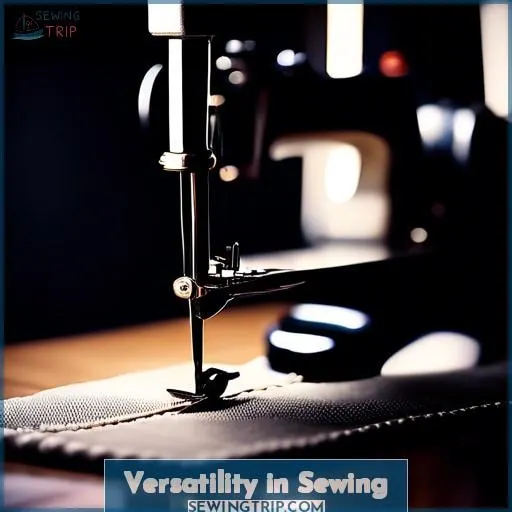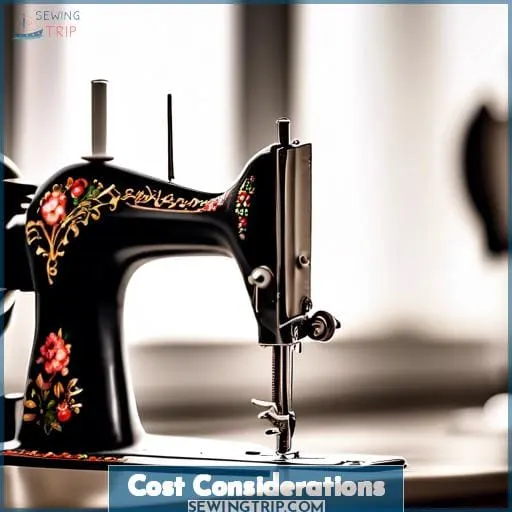This site is supported by our readers. We may earn a commission, at no cost to you, if you purchase through links.
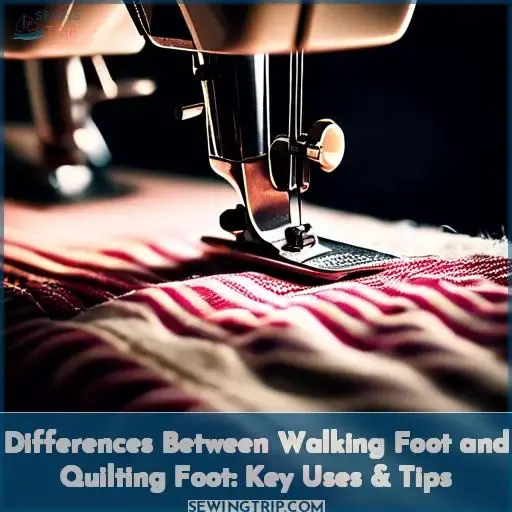 Nearly 75% of quilters agree that the right sewing machine foot can transform quilting from a chore into a joy. You’re likely familiar with the struggle of managing layers or achieving precise lines.
Nearly 75% of quilters agree that the right sewing machine foot can transform quilting from a chore into a joy. You’re likely familiar with the struggle of managing layers or achieving precise lines.
Enter the walking foot and quilting foot, two heroes in the world of sewing. While they might seem similar, their differences are crucial for your projects. The walking foot excels in handling multiple layers and ensuring even fabric feed, perfect for straight lines and gentle curves.
On the other hand, the quilting foot, ideal for free motion quilting, offers the freedom to create intricate designs with ease. Let’s dive into the key uses and tips for each, ensuring your quilting journey is not just easier, but also more enjoyable.
Table Of Contents
Key Takeaways
- Walking foot is designed for handling multiple layers of fabric, ensuring even feed during sewing, and is particularly useful for straight lines and gentle curves. It is a higher investment due to its specialized functionality and interchangeable soles and guides.
- Quilting foot, often used for free-motion quilting, allows for intricate designs and multi-directional fabric feeding. It is a budget-friendly option that offers flexibility and creativity in quilting projects.
- Free-motion quilting, utilizing a quilting foot, enables experimentation with curved lines, varying stitch lengths, and textured effects, making it ideal for intricate designs.
- Straight-line quilting benefits from the walking foot’s ability to keep fabric layers from shifting, maintaining control and accuracy, especially for straight lines and gentle curves.
Free Motion Quilting
When exploring the realm of free-motion quilting, you’ll find that a quilting foot offers a distinct advantage over a walking foot.
With a quilting foot attached to your sewing machine, you gain the ability to feed fabric in multiple directions, which is essential for creating intricate and detailed quilt designs.
This type of foot is particularly suited for free-motion quilting, where you guide the fabric manually to stitch patterns that require more than just straight lines.
It’s a skill that requires practice, but once mastered, it opens up a world of creative possibilities for your quilting projects.
Utilizes Quilting Foot
When diving into the world of free-motion quilting, you’re stepping into a realm where your quilting foot becomes your best ally.
The quilting foot, especially the free-motion quilting foot, is like a dance partner for your fabric, allowing it to glide, twist, and turn with ease, making intricate designs a breeze. Unlike its cousin, the walking foot, which prefers the straight and narrow path, the quilting foot is all about freedom and creativity.
It’s your go-to for painting with threads, letting your fabric move in any direction your heart desires.
And the best part? It won’t break the bank. With various types of quilting feet available, like the open toe quilting foot for better visibility or the roller foot for handling tricky fabrics, you’re equipped to tackle any project.
Whether you’re quilting a cozy blanket or adding a decorative touch to your creations, the quilting foot is your ticket to exploring the vast universe of free-motion quilting. So, when to use a quilting foot? Whenever you’re ready to unleash your creativity and add that personal touch to your quilts.
Remember, the world of quilting is vast, and with the right presser feet for quilting, you’re well on your way to mastering this art form.
Enables Multi-directional Fabric Feeding
As you dive into the world of free-motion quilting, you’ll find the quilting foot becomes your best ally, allowing you to feed fabric in any direction your heart desires. Imagine the freedom of sketching intricate open designs or complex patterns directly onto your quilt, with the fabric moving as freely under the needle as a leaf in the wind.
This intentional quilting technique is perfect for detailed work that brings your quilt to life, making every stitch a part of a larger masterpiece.
Unlike the walking foot, which is bound to the straight and narrow, the quilting foot is like a dancer, gracefully guiding the fabric through a waltz of stitches. It’s the difference between a well-ordered march and an expressive dance across your quilt.
With multi-directional fabric feeding, you’re not just sewing; you’re orchestrating a symphony of stitches that transform a simple quilt into a work of art. And let’s not forget, while the walking foot may be the go-to for handling multiple layers in straight-line sewing, the quilting foot is the unsung hero for those who dare to quilt outside the lines without breaking the bank.
Ideal for Intricate Designs
When diving into the world of intricate designs with free motion quilting, you’re embarking on a journey that’s both artistic and liberating.
- Experiment with Curved Lines: Unlike straight-line quilting, free motion allows you to create beautiful, flowing curves and swirls. This freedom lets your creativity run wild, turning each quilt into a unique masterpiece.
- Play with Varying Stitch Lengths: By varying your stitch lengths, you can add texture and depth to your designs. It’s like painting with thread, where each stitch contributes to the overall picture.
- Utilize a Free Motion Quilting Foot: Whether you opt for a spring-formed free motion quilting foot or a closed toe quilting foot, these tools are essential. They provide the stability and visibility needed to navigate detailed patterns effortlessly.
- Incorporate Textured Effects: Free motion quilting isn’t just about the design; it’s also about the texture. By layering stitches and playing with tension, you can create raised, textured effects that bring your quilts to life.
Straight Line Quilting
When it comes to straight line quilting, the walking foot is your go-to attachment. It ensures that the fabric layers feed evenly through your sewing machine, making it ideal for quilting straight lines and gentle curves.
This tool is indispensable for achieving precise and professional-looking results, especially on projects where fabric alignment is crucial.
Utilizes Walking Foot
When you’re diving into straight line quilting, you’re in for a treat with the walking foot, or as some quilters joke, the even-feed foot. It’s like having an extra set of hands, guiding your quilt sandwich through the machine with the precision of a Swiss watch.
No more puckers or tugs—just smooth sailing. Think of it as your quilt’s best buddy, ensuring every line is as straight as an arrow and every patchwork piece is perfectly aligned. It’s a bit like having a secret weapon for tackling those tricky fabrics that like to slip and slide.
And when it comes to binding placement, it’s a game-changer, keeping everything in place like a pro. Sure, it might be a bit pricier than its free-spirited cousin, the quilting foot, but it’s worth every penny for the peace of mind it brings to your quilting projects.
So, rev up your machine, let those feed teeth do their magic, and watch as your straight lines come out looking like they were drawn with a ruler.
Ensures Fabric Layers Feed Evenly
When you’re diving into straight-line quilting, you’re aiming for a masterpiece where every layer behaves, staying perfectly aligned like a well-rehearsed chorus line.
That’s where your walking foot steps in as the choreographer. It’s like having an extra pair of hands, ensuring that the multiple layers of your quilt sandwich feed evenly through your machine, without any fabric trying to steal the spotlight by puckering or shifting.
It’s a must-have for quilting that’s as straight as an arrow and as smooth as silk. So, when you’re quilting those straight lines or gentle curves, remember, your walking foot is your secret weapon for keeping everything in check, making sure your intricate designs don’t end up looking like they had a tussle with a tornado.
Best for Straight Lines and Gentle Curves
When it comes to straight-line quilting, the walking foot is your secret weapon. Think of it as the steady hand guiding your fabric through a maze of stitches.
It’s all about maintaining control, ensuring your fabric doesn’t dance away under the needle. With the walking foot attached, your sewing machine transforms into a precision tool, capable of handling fabric layers with grace and accuracy.
This foot is particularly adept at managing the tension adjustment, stitch length, and presser foot pressure, ensuring every stitch is placed with intention. Whether you’re navigating through the thick and thin of your quilt layers or aiming for that perfect ¼” seam allowance, the differences between the walking foot and quilting foot become clear.
The walking foot keeps things moving smoothly and evenly, making it ideal for those straight lines and gentle curves that define the character of your quilt. So, when you’re ready to quilt in straight lines, remember, the walking foot is your steadfast companion, ensuring every stitch contributes to the masterpiece you’re creating.
Handling Fabrics
When handling fabrics, it’s crucial to choose the right sewing machine foot to ensure the best results for your project.
If you’re working with multiple layers or difficult materials, a walking foot can be your best ally, providing even feeding and preventing fabric puckering.
On the other hand, for free-motion quilting or when you need the flexibility to sew in any direction, a quilting foot offers the freedom and versatility you need.
Walking Foot for Difficult Materials
When tackling those pesky slippery fabrics or sewing through heavy, thick layers, the walking foot is your secret weapon. Think of it as the superhero of sewing machine feet, swooping in to save the day when you’re wrestling with vinyl or trying to keep slippery fabrics from sliding away like a fish.
Its superpower? Providing that extra bit of feeding assistance to ensure everything moves under the needle in perfect harmony. Whether you’re binding the edges of a quilt or navigating the treacherous terrain of thick seams, the walking foot keeps things steady and straight, without any fabric trying to do a Houdini on you.
So, next time you’re faced with a sewing challenge that feels like climbing a mountain in roller skates, remember the walking foot is there to give you the grip you need to reach the summit.
Quilting Foot for Free Motion on Various Fabrics
When diving into the world of free-motion quilting with your sewing machine, you’re embarking on a journey that’s as thrilling as it’s intricate.
- Choose the Right Foot: Opt for a non-hopping spring foot for a smooth ride over your quilt’s hills and valleys. This choice can make or break your quilting experience, ensuring you glide over various fabric types with ease.
- Mind Your Tension Settings: Like tuning a guitar, getting your tension settings just right can turn a frustrating experience into a harmonious one. Too tight, and you’ll be fighting your fabric; too loose, and you’ll end up with a bird’s nest on the underside of your quilt.
- Select the Appropriate Needle Size: A quilting needle, size 90/14, is your best friend here. It’s like choosing the right sword for battle—sharp, strong, and capable of piercing through multiple layers without breaking a sweat.
- Embrace the Complexity: Each project’s complexity is a new puzzle to solve. Whether aiming for a textured or embossed effect, free-motion embroidery, or simply navigating through the layers, remember that each stitch is a step towards mastery.
By keeping these tips in mind, you’ll not only enhance your quilting experience but also unlock new levels of creativity and innovation in your projects. Remember, quilting isn’t just about connecting pieces of fabric; it’s about weaving your own story, one stitch at a time.
Sewing Machine Compatibility
When considering the compatibility of sewing machine feet, particularly the walking foot and quilting foot, it’s essential to understand their unique features and adaptability to different sewing machines.
The BERNINA walking foot is designed with interchangeable soles and guides, making it versatile for a range of BERNINA models.
On the other hand, quilting feet, including the free-motion quilting foot, offer adaptability for engaging in free-motion quilting on various machine types. This adaptability ensures that regardless of your sewing machine model, you can find a quilting or walking foot that enhances your quilting projects by providing the necessary support for handling multiple layers of fabric or sewing in different directions.
BERNINA Walking Foot Features
Switching gears from handling tricky fabrics, let’s dive into the world of BERNINA’s Walking Foot, a true game-changer for your sewing projects.
Imagine having a trusty sidekick that ensures every quilt sandwich—comprising your quilt top, inner batting, and quilt backing—glides through your machine as smoothly as butter.
With its interchangeable soles, including a standard sole for general sewing, a special quilting sole for those intricate designs, and a sole with a central guide for perfect edgestitching, you’re equipped for any challenge.
Compatible across various BERNINA models, this foot is a versatile ally, especially when tackling those sticky situations with difficult materials. Whether you’re quilting, working with layers, or sewing straight lines, the Walking Foot’s dual feed mechanism ensures everything stays in place, making misaligned plaids a thing of the past.
So, let’s keep our sewing adventures on the straight and narrow, with a little help from our friend, the Walking Foot.
Quilting Foot Adaptability
Your quilting foot is like a Swiss Army knife for your sewing machine, offering a range of options that make tackling intricate designs and multi-layered quilts a breeze. Its adaptability is unmatched, allowing you to feed fabric in any direction, which is a game-changer for those rag or denim quilts that seem to have a mind of their own.
Unlike its cousin, the walking foot, which prefers the straight and narrow path, your quilting foot dances around plaids and printed designs with the grace of a ballerina, making minor errors disappear as if by magic.
Whether you’re navigating the tight turns of a complex pattern or ensuring your quilt layers stay as snug as a bug, this foot’s versatility and fabric compatibility are your secret weapons.
So, let’s quilt away, knowing those layers are in good hands—or should I say feet?
Versatility in Sewing
When considering the versatility of sewing machine feet, it’s important to understand the distinct functions of a walking foot versus a quilting foot.
Your walking foot is a jack-of-all-trades, adept at handling a variety of fabrics and tasks, from straight-line quilting to managing slippery materials and heavy fabrics.
On the other hand, a quilting foot shines in specialized quilting techniques, particularly free-motion quilting, allowing for creative expression with fabric movement in any direction.
Both feet are valuable tools, but each excels in different scenarios, enhancing your sewing experience based on the project at hand.
Walking Foot for a Range of Sewing Tasks
Your walking foot, often referred to as an evenfeed, is a jack-of-all-trades in the sewing world. It’s like having an extra pair of hands, keeping everything in check—no puckering, no plain gaps, just smooth sailing.
Imagine you’re bias binding a quilt; this foot is your trusty sidekick, ensuring that every stitch is a step towards perfection. It’s not just for straight lines either; with a bit of finesse, you can navigate gentle curves and come out with seam finishing that’s nothing short of professional.
And let’s not forget, when it comes to curved quilting, the walking foot can be a game-changer. Sure, it mightn’t be as nimble as a ballerina, but it’ll get you through the tough spots without breaking a sweat.
So, when you’re ready to tackle that binding attachment, remember, the walking foot is your unsung hero, making sure every piece fits together like a well-orchestrated symphony.
Quilting Foot for Specialized Quilting Techniques
While the walking foot is your go-to for tackling straight lines and managing tricky fabrics, the quilting foot is your secret weapon for specialized quilting techniques.
It’s like having a nimble dance partner for your fabric, allowing you to glide through complex designs with grace. With a quilting foot, you’re not just stitching; you’re orchestrating a ballet of threads.
Whether you’re navigating the twists of free-motion quilting or ensuring precision with a ¼” foot, you’re equipped to handle the intricacies of fabric preparation, stitch considerations, and design complexity.
It’s about making every piece a masterpiece, without breaking the bank on foot compatibility.
Cost Considerations
When considering the purchase of sewing machine feet, you’re faced with a choice between the quilting foot and the walking foot.
You’ll find that the quilting foot is a budget-friendly option, often less expensive than the walking foot, which is a higher investment due to its specialized design and capabilities.
If you’re keen on free-motion quilting or working with intricate designs, the quilting foot might be your go-to, while the walking foot is indispensable for straight-line sewing and handling multiple layers with ease.
Walking Foot as a Higher Investment
When you’re weighing the pros and cons of a walking foot for your sewing machine, think of it as an investment piece.
- A Stitch in Time Saves Nine: With a walking foot, you’re not just buying a tool; you’re investing in precision. Say goodbye to mismatched seams and hello to perfect plaids and stripes.
- Tough as Old Boots: This foot laughs in the face of sticky leather and bulky upholstery. It’s like having a sewing bouncer showing difficult fabrics the door.
- The Long Haul: Think of it as the 4×4 of sewing machine feet. It’s built for the journey, no matter how heavy the load.
Quilting Foot as a Budget-friendly Option
When it comes to quilting, every penny counts, and the quilting foot emerges as a budget-friendly champion.
Unlike its pricier cousin, the walking foot, the quilting foot is an affordable choice that doesn’t skimp on functionality. It’s the low-cost alternative that punches above its weight, offering value for money that’s hard to beat.
Whether you’re navigating the intricate dance of free-motion quilting or adding those final touches with precision, this inexpensive compared to walking foot tool is your trusty sidekick. It’s proof that you don’t have to break the bank to unlock the full potential of your quilting projects.
So, if you’re looking to stretch your dollars without compromising on quality, the quilting foot is your go-to option.
Frequently Asked Questions (FAQs)
How do you maintain and clean a quilting foot or walking foot to ensure its longevity?
To maintain your quilting or walking foot, clean it after each project. Use a soft brush to remove lint and a drop of oil on moving parts.
Keep it dry and store it properly to avoid rust.
Can a quilting foot or walking foot be repaired if it breaks, and what are the common issues that might arise with these feet?
Just when you thought your sewing adventure hit a snag with a broken quilting or walking foot, turns out, there’s hope yet!
Common issues like misalignment, sticking, or uneven feeding often boil down to compatibility, installation hiccups, or the need for a simple adjustment or cleaning.
Whether it’s a quirky lever out of place or a stubborn screw needing a twist, a bit of DIY tinkering can breathe new life into your trusty foot.
And if all else fails, sometimes a drop of oil or a quick chat with your sewing guru can patch things right up.
So, before you throw in the towel, remember, every stitcher has their share of oops moments, but it’s the fixes that weave the real tales of triumph!
How does the choice between a quilting foot and a walking foot affect the final texture and appearance of a quilt?
When choosing between a quilting foot and a walking foot for quilting, the final texture and appearance of your quilt are influenced differently.
A walking foot ensures precise alignment, preventing fabric shifts, while a quilting foot allows more creative freedom with free-motion designs.
Are there any specific thread types or weights that work better with a quilting foot versus a walking foot for different quilting projects?
For quilting projects, lighter threads like 50wt cotton are versatile workhorses.
Heavier 40wt cotton makes quilting pop.
Use fine 80wt for subtle stitches.
Consider thread type for fabric grip with a walking foot.
How do environmental factors, such as humidity or fabric storage conditions, influence the performance of quilting and walking feet during sewing?
High humidity can make fabrics trickier to handle, causing them to stretch or contract.
Dry conditions might lead to static.
Store your fabrics in a cool, dry place to keep your quilting and walking feet gliding smoothly.
Conclusion
Are you ready to elevate your quilting experience? Understanding the differences between a walking foot and a quilting foot is essential.
A walking foot is your go-to for managing multiple layers, ensuring even fabric feed, and is perfect for straight lines and gentle curves. Meanwhile, the quilting foot shines in free motion quilting, allowing you to create intricate designs with ease.
Whether you’re working with challenging materials or aiming for specialized techniques, choosing the right foot can make all the difference. Remember, while a walking foot may be a higher investment, its precision is unmatched.
Conversely, a quilting foot is more budget-friendly and offers great versatility for creative quilting.
So, which foot will you choose for your next project to make quilting a joy rather than a chore?

